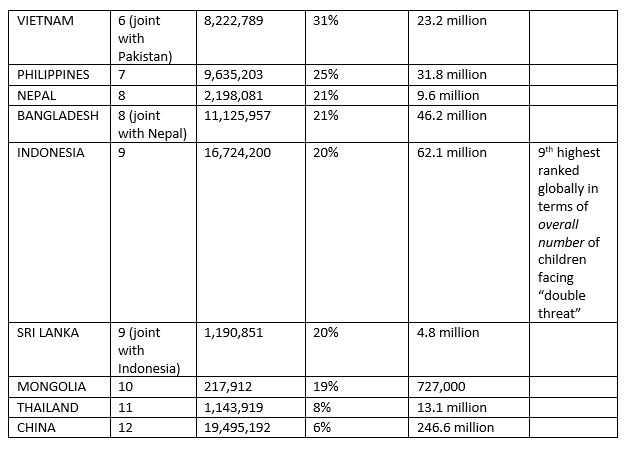222 million children in india face double threat of climate disaster and crushing poverty: report by bal raksha bharat
New Delhi, 26 October – More than 222 million children across India – 51% of the country’s children – are living with the dual impacts of poverty and the climate emergency, according to new research by Bal Raksha Bharat.
They are among almost 350 million children across Asia who are gripped by both grinding poverty and climate disaster. Cambodia topped the list of Asian countries most likely to face this “double threat”, with 72% of children in the country affected, followed by Myanmar (64%) and Afghanistan (57%). However, India was highest ranked globally in terms of overall number of children facing this “double threat”.
The report – Generation Hope: 2.4 billion reasons to end the global climate and inequality crisis – developed by Bal Raksha Bharat with climate modelling from researchers at the Vrije Universiteit Brussel (VUB) – found that, while 351.9 million children in India are estimated to be affected by at least one extreme climate event a year, some of them are at particular risk because they are living in poverty and so have fewer resources to protect themselves and recover.
Globally, 774 million children fall into this high-risk group, according to the report.
Higher-income countries are not immune from this “double threat”. The report found that 121 million children facing both climate disaster and poverty live in higher income countries. More than four out of ten children affected (12.3 million) live in the US or the UK.
Bal Raksha Bharat warned that, if the climate and inequality crisis is not addressed with urgency, the frequency and severity of humanitarian and cost of living crises are set to soar.
Bal Raksha Bharat’s Chief Executive Officer in India, Mr. Sudarshan Suchi, said “The climate emergency and issues of inequality are deeply connected, and cannot be dealt with in isolation from each other. In India, this connection could not be any more obvious. The disastrous floods we’ve seen in Assam, Kerala and cyclone prone Odisha hit the marginalised communities the hardest, leaving thousands of people hungry and homeless. Crises like these push people even deeper into grinding poverty and leave millions of people even more vulnerable to the next flood or drought.
As leaders prepare to travel to the COP27 and G20 summits in November, and especially as India gears up to host G20 summit next year, our most vulnerable children should be at the forefront of their minds. In particular, the world’s richest countries, whose historic emissions have driven the climate and inequality crisis, must lead the way in unlocking trillions in financing for countries that are struggling to protect their children from its impacts, including through climate finance – particularly for adaptation and loss and damage.
Bal Raksha Bharat, India is one of the world’s largest nongovernmental organisations and frontrunners in responding to emergencies and humanitarian crises. Humanitarian action at Bal Raksha Bharat, India is built upon the organisation’s vision of a world in which every child realises its right to survival, protection, development and participation. It is this vision that governs the organisation’s approach to assessing issues and designing interventions that are sensitive towards the needs of vulnerable families and communities. In the past Bal Raksha Bharat India has collaborated with PwC India Foundation to voice the challenges faced by children during times of climatic crisis and sought to provide a series of practical and feasible strategies that are essential for building resilience among children in India.
For media queries:
Geeta Lama, Communications Head – Bal Raksha Bharat India
Ph: 7708655058, geeta.lama@savethechildren.in
Julia Joseph, Account Manager – Avian WE
Ph: 9711812486, julia@avianwe.com
*****************************************************************************************
NOTES TO EDITORS
- The full report can be found here once the embargo lifts on 26 October. For an embargoed copy of the report, please contact us.
- To estimate the number of children living in poverty and affected by climate risk, Bal Raksha Bharat estimated the proportion of climate-affected children and children affected by poverty in 1,925 subnational regions across 159 countries, covering 98% of the total child population.
- For the purposes of this study, the “Asia” region was defined as a list of 24 countries with a total population of 1.156bn children. Of these countries, 20 were included in the analysis with a total population of 1.146bn children (99.1% of children in Asia): Afghanistan, Bangladesh, Bhutan, Brunei, Cambodia, China, India, Indonesia, Japan, South Korea, Lao PDR, Malaysia, Maldives, Mongolia, Myanmar, Nepal, Pakistan, Philippines, Sri Lanka, Thailand and Vietnam.
- More information can be found in the full methodology note.
Data based on 20 countries in Asia with a total population of 1.146bn children.









